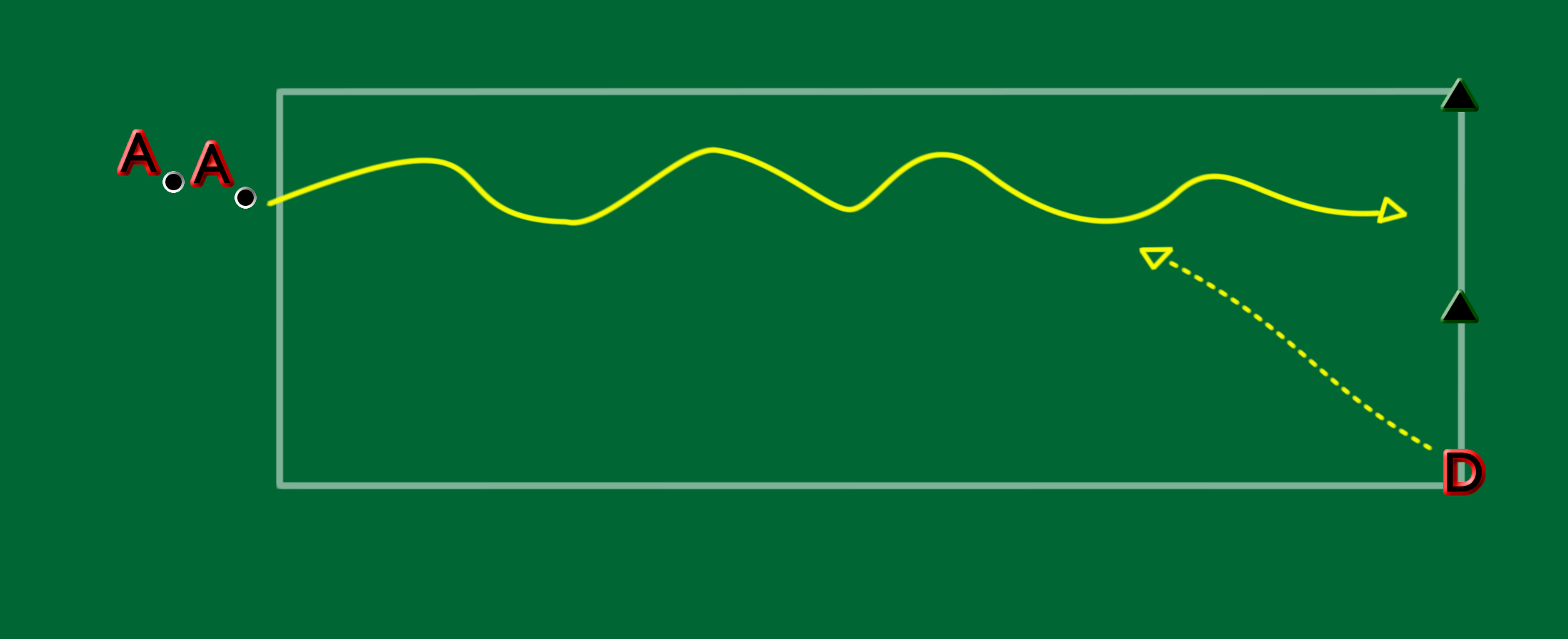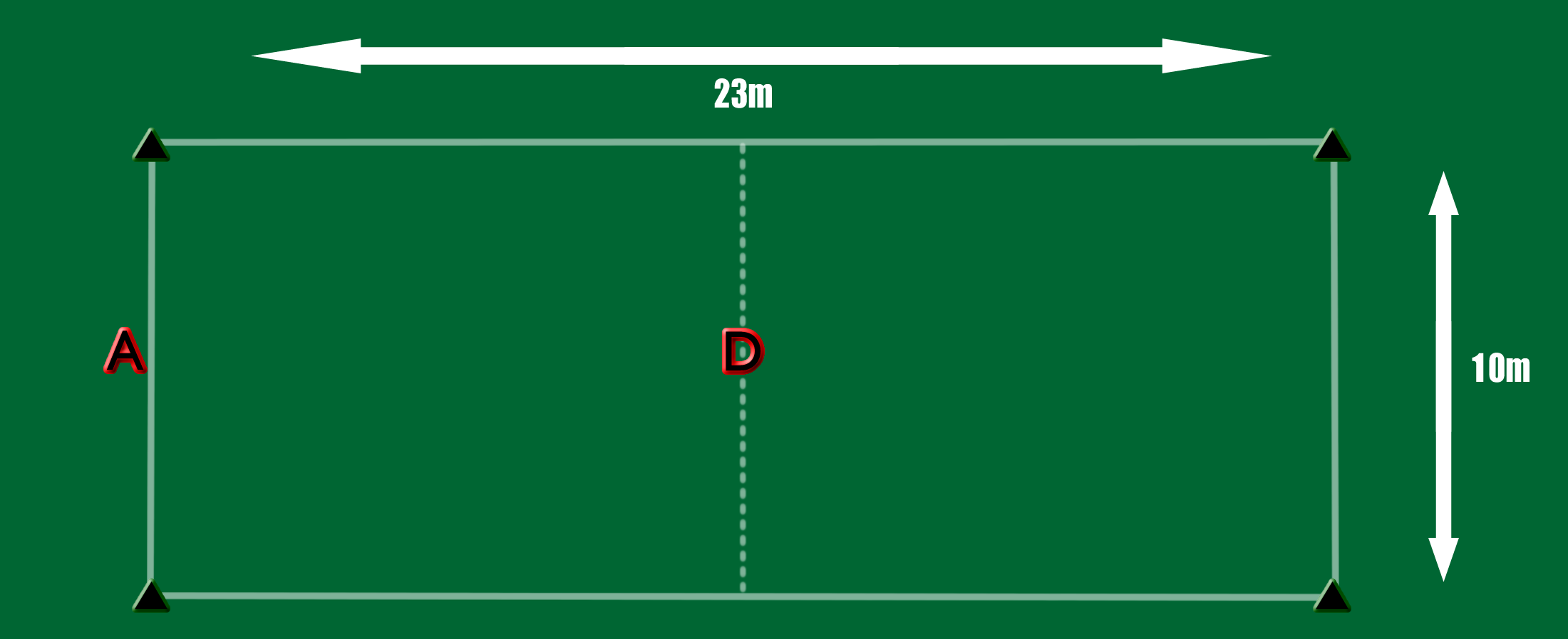FUNSTIX - Lesson 6
THEMES FMS; agility, running, side steps, cross steps, skipping, forward and backward, shuffle steps, pivots, reaching, lunging, balance, catching, throwing
TECHNICAL: Defensive -Block tackle; Offensive – Changing Directions While Dribbling
TACTICAL: Defensive - Staying Goal side of the ball carrier; Offensive- Getting Goal side of the ball carrier
THEMES FMS; agility, running, side steps, cross steps, skipping, forward and backward, shuffle steps, pivots, reaching, lunging, balance, catching, throwing
TECHNICAL: Defensive -Block tackle; Offensive – Changing Directions While Dribbling
TACTICAL: Defensive - Staying Goal side of the ball carrier; Offensive- Getting Goal side of the ball carrier
Activity 1
8 minutes Players are in scattered formation within the playing area, holding their sticks in two hands. Following instructors command, they perform the following movements; jogging forward, moving sideways left and right (using side steps), moving forward using shuffle steps (RLR, LRL)then moving backwards using shuffle steps (RLR, LRL), jogging forward with high knees; sprinting forward 15 yards and move backwards as quickly as possible using backward shuffle steps; run sideways 10 yards and lunging to the left and right to extend the body and the stick as far as possible to the right and the left; skip forward anywhere in open space. Instructors must ensure that players are well spread out.
Activity 2
10 minutes Dancing Dribblers In lines of no more than 3 players, each player with a ball dribbles in and out of the cones, using a straight dribble. When they reach the last cone, the player picks up the ball and runs outside the square back to the starting line using different locomotor movements each time. The instructor should encourage players to change the speed of their dribble, use small steps with quick feet, and keep their body behind the ball at all times.

Activity 3
6 minutes Knee Slappers Players are assigned a partner of equal size. Each pair of players stand within a 5 yard square in the ‘ready position’ 3 yards away from each other. Using quick feet, the players try to tap the back of the other player’s knees by extending their left or right leg forward but keeping the other foot stationary on the ground. Players should be encouraged to quickly return to ‘ready position’ in order to avoid been tagged by their partner. Count the number of taps each player makes in 30 seconds. Players may move any way around the square but not physically block their opponent. Stress good defensive position, getting low, and footwork. This activity is performed without sticks.
Activity 4
10 minutes Block and Stop * Two players, each with a ball, stand one behind the other, at the end, and at the right side of a 10 by 5 yard grid. The D player stands on the left side of the other endline on which are placed 2 cones, one yard apart, on the right side of the same line. One of the players with the ball (A) moves forward, attempting to carry the ball through the two cones. As ‘A’ moves to the left in the direction of the cones, ‘D’ steps forward, closes the space and uses a block tackle to prevent ‘A` from moving through the cones with the ball. If D gets the ball, the ball is pushed outside the square over the sideline. After both attackers have had 2 turns, the players rotate positions.

Activity 5
i) 8 minutes Out of My Way * (without balls or sticks) In assigned partners of equal speed and physical size, one player (A) stands at the start line facing their partner (D) who starts half way between the start line and the endline which is 25 yards away. The ‘A’ player’s objective is to get past D and across the endline. The D player’s objective is to tag A before A crosses the endline. A must stay far enough away from D to avoid being tagged. D stays between the A player and the endline, waiting for an opportunity to tag A. There can be no body contact. D uses side steps and backward shuffle steps to try and stay in front of A. A uses feints, direction changes, change of speed to try and get past D. D stays far enough away in order to react to A’s movements. If A gets past D, D must run and sprint to regain the correct position between A and the endline. The playing lane should be 10 yards wide. Instructors should ensure sufficient space between each pair and should alternate pairs in order to give players a chance to rest. MAKE THIS ACTIVITY HARDER FOR ‘A’: make the area more narrow and shorter.

ii) 10 minutes As above but with a ball and a stick; the objective in this case is for D to use a block tackle and take the ball away from A. Encourage the D player to use good reverse footwork to stay between A and the goal line and wait for the opportunity to tackle. A should be encouraged to change the pace (slow down, speed up) and change directions (go towards the side line) and then sprint past D.
LESSON 6 CONTENT LEARNING DESCRIPTORS
FUNDAMENTAL MOVEMENT SKILLS
SIDE STEPS: the body moves left or right with the side of the body leading and the toes of the feet at right angles to the direction of travel; the steps should be short, weight is on the balls of the feet, primarily on the leading leg with the trailing foot touching the ground and quickly pushing off. The feet should be close to the ground during sidesteps.
SKIPPING : a series of step hops done with alternate feet. Teach skipping by having learners step and hop on the same foot and then step and hop on the other foot swing arms to shoulder height in opposition with the feet, skip on the balls of the feet, keep movements smooth, speed and distance are not important, transfer weight from one foot to the other while doing the hop, step-hop, swing smoothly.
CROSS STEPS (karaoke): Also known as grapevine steps; the body moves sideways while the trailing leg crosses in front and then behind the leading leg. For field hockey purposes, players should focus on moving with the trailing leg always crossing in front of the leading leg and should be able to perform with the left leg leading or the right leg leading. The feet should stay to the ground with the weight on the balls f the feet and the knees slightly bent.
PIVOT: one foot is in contact with the ground with the knee of that leg bent; the weight is on the ball of the foot. The other leg is bent with the weight on the ball of the foot and moves in a circle so that the body rotates around the support leg. Players should be able to pivot forwards or backwards, in both directions.
SHUFFLE: the feet move in the following sequence-right, left, right; left, right left, the weight is on the balls of the feet with the knees slightly bent; the feet move quickly with short steps and the back foot never passes the front foot; the feet stay close to the ground.
BASIC STANCE (READY POSITION): feet shoulder width apart, keep feet below your shoulders; left foot slightly ahead of the right; weight low (sit); head Stick head rests on the ground in front and slightly to the right of the body. Player should be looking forward with head up for maximum vision and not down at their feet.
CATCHING : (to make catching easier, increase the size of the ball) Arms relaxed at the sides with forearms in front of the body; players should reach for the ball, place their hands on the sides of the ball, bend their arms and bring the ball towards their chest watching the ball right into their hands. Encourage players to take a step back and bring their elbows towards their chest to help absorb the force of the ball.
FEINTS: a fake movement of the head, or other parts of the body, when the actual intent is to go in another direction.
OVERHAND THROWING (to make throwing easier, decrease the size of the ball) The non - throwing side faces the target; swing the throwing arm out to the side and backwards bringing the arm with the ball behind the ear, keeping the elbow out; twist the body towards the arm that is holding the ball, keep the other arm raised for balance; extend the throwing arm forward and point the thumb towards the ground while stepping forward with the weight on the foot that is closer to the target; twist the body toward that leg as the ball is released.
REACHNG (STRETCHING): are movements that move a part of the body away from the centre or trunk. Players should reach slowly, and smoothly and avoid bouncing.
LUNGING: one foot is anchored to the ground with the knee straight; the other leg reaches, extends, (lunges) away from the support leg. The knee of the lunging leg should never extend past the toes of the support leg.
TECHNICAL ; Block Tackle: Purpose- To take the ball away for the opponent (D1) by blocking the forward movement of the ball with the stick;. Use the standard grip; feet are staggered with left foot forward and right foot slightly back; knees are bent; the stick is kept low (almost flat) on the ground in front of the feet. The tackler should line up with the ball carrier so that the two sticks are opposite each other. When executing the tackle, the stick should be held firmly in the hands with the left hand a bit ahead of the right hand; the stick should not be swung toward the ball but should slide along the ground. As the defender lunges to make the tackle; at the point of the tackle the defender should be stationary and balanced with the body weight low.
TACTICAL: Goal Side Positioning- the player executing a block tackle should always be closer to their defending goal line than the ball carrier. All non possession team players strive to stay closer t o the defending goal than their opponents while players on the offensive team try to get between their opponents and the goal they are attacking.
Filtering
Instructions for Filtering the Resource Centre.
Click on a specific tag in the filter list to view articles and resources related to that tag.
For example, click on Attacking to filter the resource centre for attacking.
You can also do keyword based searching.

